The battle between electric SUVs is heating up, with two giants in the automotive industry stepping into the ring: the Audi Q4 e-tron and the Mercedes EQA. Both vehicles offer a fusion of advanced electric technology, luxurious features, and versatility. However, they each carry distinct characteristics that appeal to different preferences and driving styles. In this comparison, we’ll delve into the technical aspects, innovations, and overall performance of these two remarkable models.
Audi Q4 e-tron vs Mercedes EQA – Performance, range & efficiency compared
Everyday use, family trips or long-distance drives – here’s where the differences show.
Discover whether Audi Q4 e-tron or Mercedes EQA fits your lifestyle better.
Design and Body Type
Both the Audi Q4 e-tron and the Mercedes EQA fall under the SUV category, boasting a compact yet powerful design. The Q4 e-tron measures 4588 mm in length, 1865 mm in width, and 1632 mm in height, giving it a robust stance on the road. In contrast, the EQA is slightly smaller at 4463 mm in length and 1834 mm in width, but its sleek lines and signature Mercedes aesthetics present a sophisticated look. Both vehicles come with five doors and comfortably seat up to five passengers, making them practical choices for families and urban living.
Powertrains and Performance
When it comes to propulsion, the Audi Q4 e-tron offers a range of power options, including rear-wheel drive and all-wheel drive configurations. The power output varies from 170 HP to a thrilling 340 HP. With acceleration times ranging from a solid 9 seconds to an impressive 5.4 seconds from 0 to 100 km/h, the Q4 e-tron showcases its sporty capabilities.
On the other hand, the Mercedes EQA presents its own array of power options, with capacities lying between 190 HP and 292 HP. The EQA accelerates slightly slower than its Audi counterpart, clocking in at 8.6 seconds for the base model and 6 seconds for the top-tier variant. While the acceleration performance of the EQA is commendable, it does tend to lag behind the Q4 e-tron in speed, offering a maximum of 160 km/h compared to Q4's higher variant speed of 180 km/h.
Battery and Range
The Audi Q4 e-tron features two battery configurations, with a capacity of either 52 kWh or 77 kWh. The vehicle offers an impressive electric range, with the maximum reaching up to 554 km. Despite its larger dimensions, the efficiency of the Q4 e-tron is evident, with electric consumption figures ranging between 15.9 kWh/100km and 17.4 kWh/100km.
Conversely, the Mercedes EQA is equipped with battery options of 66.5 kWh and 70.5 kWh. It also presents a strong electric range, with numbers varying between 458 km and 561 km. Its consumption figures are quite favorable, averaging around 14.4 kWh/100km and 16.9 kWh/100km, allowing it a slight edge in efficiency.
Interior and Technology
Both vehicles provide a blend of luxury and functionality inside. The Q4 e-tron prides itself on its high-quality materials, spacious interior, and a technologically advanced MMI infotainment system that supports various connectivity options. Cargo space in the Q4 e-tron measures a generous 535 liters, ensuring ample room for luggage or shopping.
The EQA, while it has a smaller trunk capacity of 340 liters, boasts a modern interior featuring Mercedes' latest MBUX infotainment interface, which is renowned for its intuitive usability. Both vehicles prioritize comfort, with a focus on driver and passenger ergonomics. However, the choice between the two may hinge on personal preference for either Audi or Mercedes' design philosophy.
Conclusion: Which One to Choose?
In conclusion, the choice between the Audi Q4 e-tron and the Mercedes EQA primarily depends on individual preferences and needs. The Q4 e-tron is ideal for those who prioritize performance and a larger electric range, while the EQA may appeal to consumers looking for cutting-edge technology and efficient energy consumption in a slightly more compact package.
Ultimately, both vehicles stand as excellent representations of their respective brands, setting high standards in the electric SUV market. Whether you lean towards Audi's sporty performance or Mercedes’ elegant technology, you’re bound to be impressed by the innovations and capabilities these electric SUVs offer.
Here’s where it gets real: The technical differences in detail
Costs and Efficiency:
When it comes to price and running costs, the biggest differences usually appear. This is often where you see which car fits your budget better in the long run.
Audi Q4 e-tron has a a bit advantage in terms of price – it starts at 39600 £, while the Mercedes EQA costs 44200 £. That’s a price difference of around 4680 £.
In terms of energy consumption, the advantage goes to the Mercedes EQA: with 14.40 kWh per 100 km, it’s to a small extent more efficient than the Audi Q4 e-tron with 15.90 kWh. That’s a difference of about 1.50 kWh.
As for range, the Mercedes EQA performs barely noticeable better – achieving up to 561 km, about 7 km more than the Audi Q4 e-tron.
Engine and Performance:
Under the bonnet, it becomes clear which model is tuned for sportiness and which one takes the lead when you hit the accelerator.
When it comes to engine power, the Audi Q4 e-tron has a a bit edge – offering 340 HP compared to 292 HP. That’s roughly 48 HP more horsepower.
In acceleration from 0 to 100 km/h, the Audi Q4 e-tron is slightly quicker – completing the sprint in 5.40 s, while the Mercedes EQA takes 6 s. That’s about 0.60 s faster.
In terms of top speed, the Audi Q4 e-tron performs somewhat better – reaching 180 km/h, while the Mercedes EQA tops out at 160 km/h. The difference is around 20 km/h.
There’s also a difference in torque: Audi Q4 e-tron pulls noticeable stronger with 679 Nm compared to 520 Nm. That’s about 159 Nm difference.
Space and Everyday Use:
Beyond pure performance, interior space and usability matter most in daily life. This is where you see which car is more practical and versatile.
Both vehicles offer seating for 5 people.
In curb weight, Audi Q4 e-tron is slight lighter – 2035 kg compared to 2045 kg. The difference is around 10 kg.
In terms of boot space, the Audi Q4 e-tron offers noticeable more room – 535 L compared to 340 L. That’s a difference of about 195 L.
In maximum load capacity, the Audi Q4 e-tron performs slightly better – up to 1490 L, which is about 170 L more than the Mercedes EQA.
When it comes to payload, Audi Q4 e-tron somewhat takes the win – 515 kg compared to 425 kg. That’s a difference of about 90 kg.
Who comes out on top?
Overall, the Audi Q4 e-tron shows itself to be wins the duel decisively and secures the title of DriveDuel Champion.
It convinces with the more balanced overall package and proves to be the more versatile choice for everyday use.
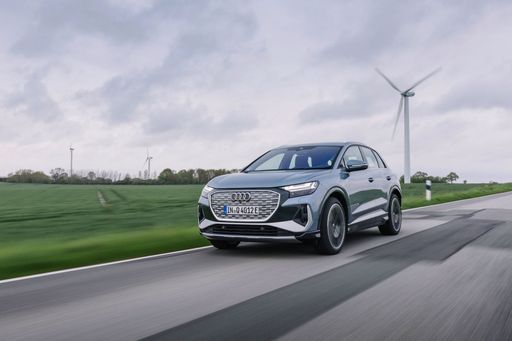 @ Audi AG
@ Audi AG
Audi Q4 e-tron
Audi Q4 e-tron
The Audi Q4 e-tron brings Audi polish into the electric crossover scene, pairing a sleek exterior with a refined, airy interior that makes everyday driving feel distinctly premium. It’s an easy-to-live-with EV that balances comfort and real-world usability with intuitive tech, making it a smart choice for buyers who want electric mobility without giving up Audi character — and yes, it still looks good in the driveway.
details @ Audi AG
@ Audi AG
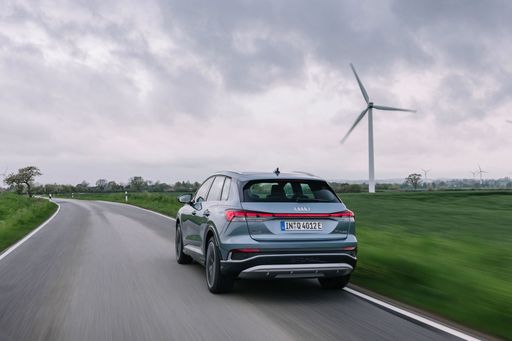 @ Audi AG
@ Audi AG
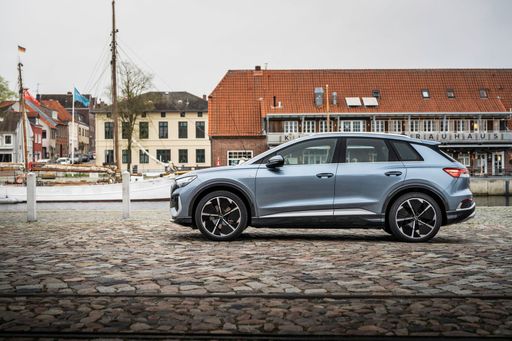 @ Audi AG
@ Audi AG
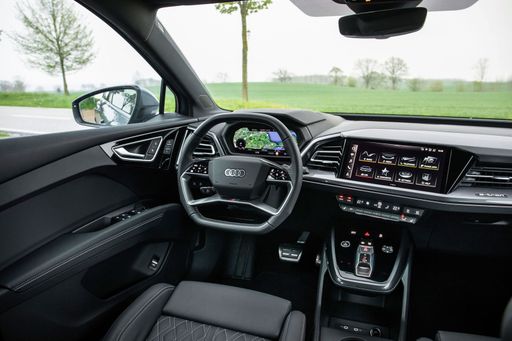 @ Audi AG
@ Audi AG
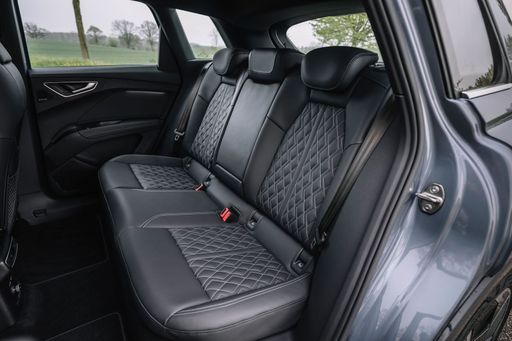 @ Audi AG
@ Audi AG
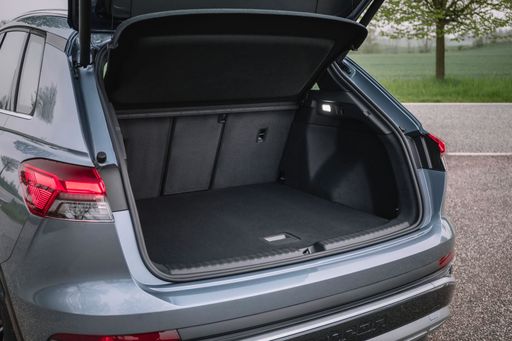 @ Audi AG
@ Audi AG
Mercedes EQA
The Mercedes EQA slips into the electric crossover ranks with the brand’s familiar luxury polish, offering a quiet, fuss-free drive that feels perfectly at home in the city or on a country escape. Inside it’s neatly finished and tech-forward, projecting grown-up refinement even if it plays things a bit safe for anyone chasing outright excitement.
details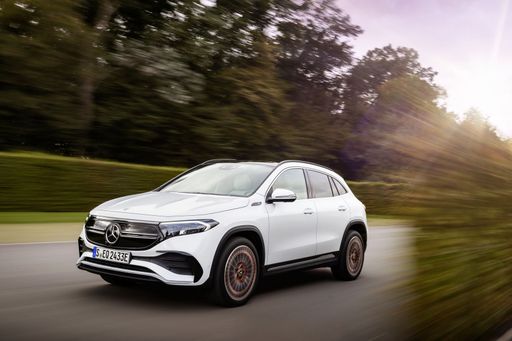 @ Mercedes-Benz Group Media
@ Mercedes-Benz Group Media
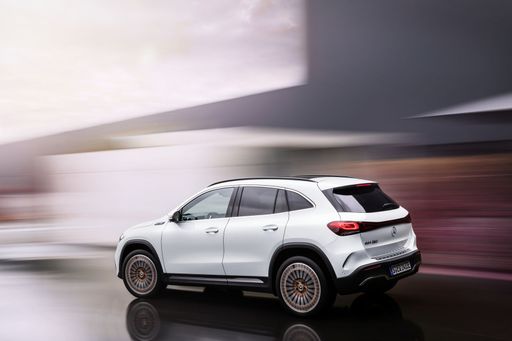 @ Mercedes-Benz Group Media
@ Mercedes-Benz Group Media
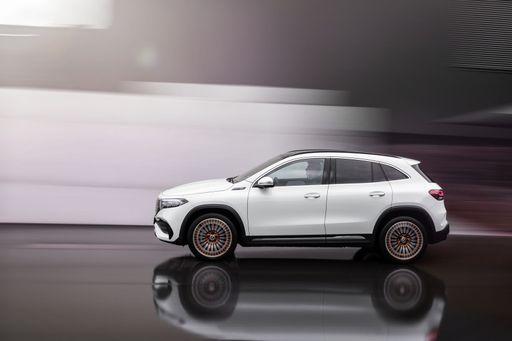 @ Mercedes-Benz Group Media
@ Mercedes-Benz Group Media
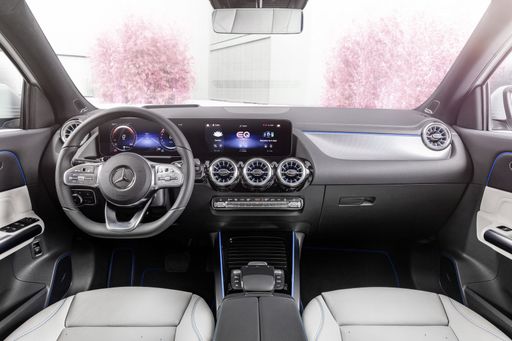 @ Mercedes-Benz Group Media
@ Mercedes-Benz Group Media
 @ Audi AG
@ Audi AG
|
 @ Mercedes-Benz Group Media
@ Mercedes-Benz Group Media
|
|
|
|
Costs and Consumption |
|
|---|---|
|
Price
39600 - 58800 £
|
Price
44200 - 57400 £
|
|
Consumption L/100km
-
|
Consumption L/100km
-
|
|
Consumption kWh/100km
15.9 - 17.4 kWh
|
Consumption kWh/100km
14.4 - 16.9 kWh
|
|
Electric Range
406 - 554 km
|
Electric Range
476 - 561 km
|
|
Battery Capacity
59 - 77 kWh
|
Battery Capacity
70.50 kWh
|
|
co2
0 g/km
|
co2
0 g/km
|
|
Fuel tank capacity
-
|
Fuel tank capacity
-
|
Dimensions and Body |
|
|---|---|
|
Body Type
SUV
|
Body Type
SUV
|
|
Seats
5
|
Seats
5
|
|
Doors
5
|
Doors
5
|
|
Curb weight
2035 - 2235 kg
|
Curb weight
2045 - 2115 kg
|
|
Trunk capacity
520 - 535 L
|
Trunk capacity
340 L
|
|
Length
4588 mm
|
Length
4463 mm
|
|
Width
1865 mm
|
Width
1834 mm
|
|
Height
1614 - 1632 mm
|
Height
1608 - 1613 mm
|
|
Max trunk capacity
1460 - 1490 L
|
Max trunk capacity
1320 L
|
|
Payload
505 - 515 kg
|
Payload
425 kg
|
Engine and Performance |
|
|---|---|
|
Engine Type
Electric
|
Engine Type
Electric
|
|
Transmission
Automatic
|
Transmission
Automatic
|
|
Transmission Detail
Reduction Gearbox
|
Transmission Detail
Reduction Gearbox
|
|
Drive Type
Rear-Wheel Drive, All-Wheel Drive
|
Drive Type
Front-Wheel Drive, All-Wheel Drive
|
|
Power HP
204 - 340 HP
|
Power HP
190 - 292 HP
|
|
Acceleration 0-100km/h
5.4 - 8.1 s
|
Acceleration 0-100km/h
6 - 8.6 s
|
|
Max Speed
160 - 180 km/h
|
Max Speed
160 km/h
|
|
Torque
310 - 679 Nm
|
Torque
385 - 520 Nm
|
|
Number of Cylinders
-
|
Number of Cylinders
-
|
|
Power kW
150 - 250 kW
|
Power kW
140 - 215 kW
|
|
Engine capacity
-
|
Engine capacity
-
|
General |
|
|---|---|
|
Model Year
2023 - 2025
|
Model Year
2024 - 2025
|
|
CO2 Efficiency Class
A
|
CO2 Efficiency Class
A
|
|
Brand
Audi
|
Brand
Mercedes-Benz
|
What drive types are available for the Audi Q4 e-tron?
The Audi Q4 e-tron is offered with Rear-Wheel Drive or All-Wheel Drive.
The prices and data displayed are estimates based on German list prices and may vary by country. This information is not legally binding.
